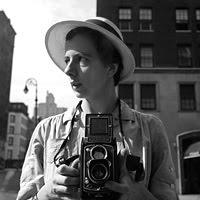Vivian Maier was born in New York City on 1 February 1926. She did a lot of photography before her death in Chicago on 21 April 2006. She worked as a nanny for most of her adult life, residing in the homes of her employers on Chicago’s north shore. She was not known as a photographer during her lifetime. The children she cared for knew she made many photographs and they would often be present on trips into some of Chicago’s worst neighborhoods when she was doing her street photography. Many of her photographs were never printed. Quite a lot of film was never developed. It was only after her death that the impressive body of work she produced with her Rolleiflex became known.
Vivian Maier has been compared to a number of other great photographers who documented the culture of their period but her style is unique. Robert Frank might be said to be closest in lineage to Maier but his work in the US (resulting in the 1958 publication of The Americans) was done through a Guggenheim grant for which he received encouragement and assistance from FSA photographer Walker Evans. Maier was self-taught and supported her art with her nanny wages. She may owe her perspective on the American scene to time spent growing up in France in the manner that Robert Frank could identify what was uniquely American as a Swiss visitor to the country.
An obvious comparison to the style of Maier’s street photographs are the photos of Weegee (Arthur Fellig) who made his living as a freelance photographer in New York in the ’30s and ’40s. Weegee is credited with summarizing his successful photographs as, “f/8 and be there.” Much of his paid work was photography of crime scenes. Weegee was also self-taught but his work was recognized by inclusion in an exhibit at MoMA organized by Edward Steichen shortly after the end of World War II.
Vivian Maier’s body of work calls into question the concept of a photograph. Did she ever expect others to view her work? Are her photographs something akin to an unpublished diary with herself the only intended beneficiary of the work? What can be said about the many exposed but undeveloped rolls of film that were in her collection; what is their value to the photographer? Did she mean these to be only personal documents without regard for what they could have conveyed to others?
It is only because of a peculiar set of circumstances that Vivian Maier’s photographs surfaced to raise these questions about the value of such photographs. Two years before Maier’s death she failed to make payments on the storage space that housed her materials and they were auctioned. One of the purchasers was John Maloof who was hoping to find documentation for a book on the Chicago neighborhood of Portage Park. A few years later Maloof was busy trying to find out something about the woman who had produced these photographs. The result was the documentary film Finding Vivian Maier which included commentary from the likes of Joel Meyerowitz and the late Mary Ellen Mark.
Finding Vivian Maier raises as many questions as it answers and only touches on the legal matters concerning copyright ownership of these photographs. There is no clear heir to Vivian Maier’s estate so, though the photographic works have found new owners, publication and sales rights are not yet defined. Whatever the photographs meant to the photographer they are an impressive body of work and deserve to be appreciated by a wide audience as soon as they are free of legal encumbrances.

